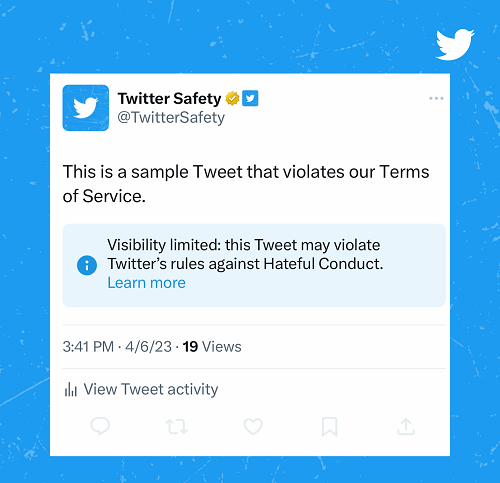As it moves to reduce the impact of its moderation actions, with a view to allowing more kinds of speech to remain on the platform, Twitter has outlined a new set of tweet-level alerts, which will be added to tweets that have had their visibility restricted in the app.

As you can see in this example, tweets that violate Twitter’s rules, but don’t break them as such, will now have these new visibility labels attached, which will let tweet creators and readers know that action has been taken to reduce a tweet’s reach and impact.
Any restriction actions will be taken at tweet level only, and will not affect a user’s account, with Twitter focusing on violations of its Hateful Conduct policy to begin with, before expanding them to other policy areas.
As per Twitter:
“Restricting the reach of Tweets, also known as visibility filtering, is one of our existing enforcement actions that allows us to move beyond the binary ‘leave up versus take down’ approach to content moderation. However, like other social platforms, we have not historically been transparent when we’ve taken this action. Starting soon, we will add publicly visible labels to Tweets identified as potentially violating our policies letting you know we’ve limited their visibility.”
So it’s shadow banning, but with upfront explanations, as opposed to the ‘shadow’ element. So ‘light banning’, I guess?
As has become the norm for Twitter 2.0, Twitter’s essentially replicating old features and elements of the app and re-branding them, then presenting them as something new – though the up-front notifications will provide additional transparency, which will help users understand when their tweets have been restricted.
Though that’ll likely lead to more appeals, which Twitter may struggle to handle with 80% less staff, while it’ll also anger many of the ‘free speech absolutists’, who disagree with censorship in any form.
Indeed, shadow banning is one of the cardinal sins that past Twitter management had been accused of, which free speech advocates had hoped would change under Elon Musk. And maybe it has, in some respects, but clearly, most of the same rules and restrictions still apply, just in different form.
It also doesn’t address the key issue of harassment, and hateful tweets being targeted at a user. If someone’s being attacked, and those tweets are left up, that user is still going to be impacted, even if those tweets are not more generally visible. The answer, in this sense, is removal – but under this new process, that will happen less often, which could lead to more problems for Twitter and users, even if the broader visibility of such is restricted.
But Elon and Co. will be hoping that transparency will be enough, in most cases, to reduce their removal actions, which could help to appease users, while also keeping ad partners happy. Ads won’t be shown on any tweet that’s been labeled, in alignment with Twitter 2.0’s ‘Freedom of Speech, not Freedom of Reach’ approach.
But it still seems problematic. The true measure really depends on what exactly Twitter decides to leave up, as opposed to removing, and where it draws the line on clear rule violations, subject to removal, and those that are borderline.
We won’t know that till the new process is in action, which begins today.



